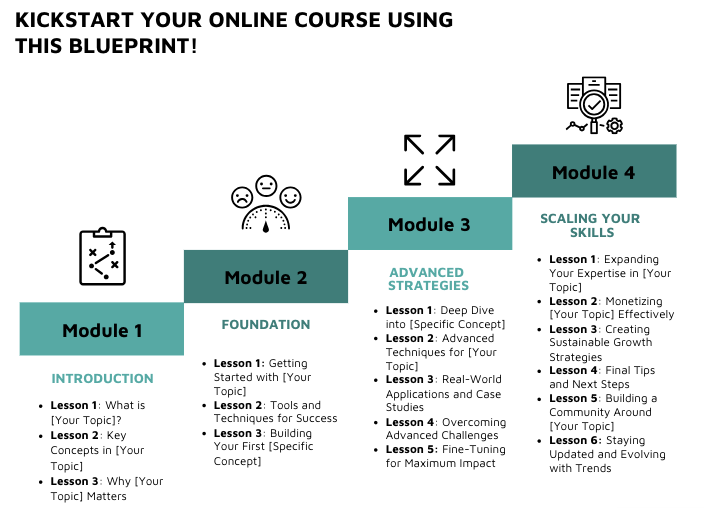Want to Create an Online Course? A 10-Step Blueprint for Success!
“Knowledge shared is knowledge squared.”
It’s a simple idea but one that holds immense power. When you share your expertise, you don’t just help others learn—you enhance your understanding, too. And here’s the kicker: you can make money while doing it!
The eLearning industry is booming, with a global valuation expected to hit $1 trillion by 2032. If you’re a professional in any field with valuable knowledge to share, now is the perfect time to tap into this growing market.
Creating an online course is one of the smartest ways to monetize your expertise, and guess what? It doesn’t have to be overwhelming or complicated.
Let’s dive into the 10 essential steps to creating a profitable online course and turn your expertise into income!
1. Create The Perfect Course Topic: Simple Roadmap
Imagine talking about something you love so much that time flies, and you don’t even realize it. That’s the kind of topic your course should be about! When you’re genuinely excited, it shows—and your audience will feel that energy too.
Plan of Action:
- Find What You Love
- Write down topics or activities that excite you. These are great starting points to create an online course that feels authentic.
- Think about what you could talk about for hours without getting bored.
- Identify What You’re Good At
- List your skills and areas of expertise.
- Think about what you can teach others confidently based on your experience.
- Check Market Demand
- Search online for popular courses or content related to your topic.
- Visit forums (like Quora or Reddit) to see if people are asking about your topic.
- Conduct polls using SurveyMonkey and see if others are interested in your topic before you start creating your online course.
Once you’ve brainstormed some potential topics, it’s time to fine-tune your choice using a method that aligns passion, skills, and market demand.
Pro Tip: Ready to discover the secret to choosing the perfect course topic? Ikigai —a game-changing framework that can help you find a course idea that not only excites you but also meets real-world needs. It’s the key to turning your passion into a profitable course!

Draw four overlapping circles. Write ideas in each circle, then find the overlap. The centre is your ideal course topic—where passion, skill, demand, and profit meet. It’s the perfect tool to ensure your course idea is both meaningful and in demand!
2. Validate Market Demand Before You Start
With India having the second-highest number of registered users (13.6 million) on Coursera, it’s clear that there is a massive demand for online courses. Validating market demand before creating your own course ensures that you tap into this growing interest and avoid investing time and resources into content that may not resonate with your target audience.
Plan of Action:
- Analyze Market Trends
- Use tools like Google Trends to see if your topic is gaining traction.
- Check out platforms like Udemy or Coursera to explore popular courses in your niche.
- Look at Competitor Courses
- Identify similar courses and see what they’re offering.
- Read reviews of these courses to understand what learners love or want improved.
- Engage in Niche Communities
- Join forums, Facebook groups, or LinkedIn communities related to your topic.
- Observe recurring questions or pain points—they’re great for course ideas!
- Test with a Beta Group
- Share your course outline with a small group of trusted individuals.
- Collect their feedback to refine your content and structure.
Pro Tip: Once you’ve laid the groundwork, take it further with Webinars or surveys to see if your idea will truly fly with your audience. Imagine hosting a free webinar where you share a sneak peek at your course or send out a survey to uncover exactly what people need.
You can host webinars and upsell your courses seamlessly with Exly’s all-in-one platform.
3. Create an Online Course That Flows Like a Story
Your course should feel like a journey—taking students step by step toward mastering your topic. A well-organized structure keeps learners hooked and ensures they achieve real results. So you need to develop a course that not just engages your students but keeps them well hooked.
Plan of Action:
- Outline Your Course Modules
- An ideal module typically contains 3 to 7 lessons to help the learner absorb and retain information.
- Group similar concepts into modules to create easily digestible sections.
- Define Lesson Goals
- For each lesson, write down what students should achieve by the end.
- Keep lessons focused and actionable to avoid overwhelming them.
- Plan the Flow
- Arrange modules in a sequence that builds knowledge step by step.
- Start with the basics and gradually move to advanced topics for smooth progression.

Pro Tip: Keep your course dynamic by combining videos, text, and downloadable resources. Add quizzes, assignments, or hands-on activities to make learning interactive. Variety keeps your students engaged and ensures they learn effectively!
4. Deliver Like a Pro: Platforms and Methods Simplified
Now that you’ve got your course topic and structure sorted, the next big decision is choosing how and where to deliver it. Should students go through it at their own pace, or would they thrive better in a live, interactive setting? Which is the right platform for your audience?
When you create an online course, you need to choose the best delivery method from the following learning methods.
| Learning | Best for | How it works | When to choose |
| Self-Paced | Students who prefer learning at their own speed. | Students can access the course material whenever they want, progressing through modules. | If you’re creating a course that involves independent learning. |
| Cohort-Based | Students who benefit from group learning. | You provide the course material in a set timeframe. This method includes collaborative activities. | If your course involves live feedback or real-time collaboration. |
| Combination of Both | Courses that offer flexibility along with live interaction. | You can have the course material be self-paced, but offer live Q&A or community check-ins. | If you want the benefits of both formats. |
Choosing the right delivery format is crucial to the success of your course. Whether you opt for a self-paced structure, a cohort-based model, or a blend of both, the key is to align the format with your audience’s needs and learning preferences.
Once you’ve settled on the format, the next step is selecting the platform that best supports your course goals.
Evaluate Platform Features, Costs, and Support Options
Not all course platforms are created equal. To make the best choice, you can evaluate the following:
- Features: Look for features that align with your course needs. Do you need video hosting, quizzes, downloadable resources, or certificates of completion? Ensure the platform supports these.
- Costs: Compare pricing plans carefully. Some platforms charge a flat monthly fee, while others take a percentage of your earnings. Choose one that fits your budget and projected revenue.
- Support: Reliable customer support is crucial. Check if the platform offers tutorials, live chat, or email support in case you need help troubleshooting.
- User Experience: The platform should be easy to navigate—for both you and your students. Consider demoing a few platforms to experience their interface firsthand.
If you’re ready to access all the features you need in one convenient platform, Exly is the solution you’ve been looking for.
Consider Standalone, All-in-One, or Marketplace Platforms
When choosing the right platform for your needs, it’s important to consider the specific features and benefits that each type offers. Below is a comparison of Standalone, All-in-One, and Marketplace platforms, highlighting which one works best for different goals and key features to help you make an informed decision.
| Platform | Best For | Key Features |
| Standalone | Experienced creators who want full control over branding and pricing. | Customizable websites, integration options and full control over course design and marketing. |
All-in-One | Beginners or creators who want simplicity and everything in one place. | Course hosting, payment processing, marketing tools, certificates, and analytics. |
Marketplace | Creators looking to reach a ready-made audience quickly. | Listing alongside other courses, marketing handled by the platform, and audience engagement tools. |
Pro Tip: With built-in marketing automation tools, you can easily manage email campaigns and promotions, saving time and increasing engagement. This lets you focus on creating impactful course content while the platform handles customer outreach seamlessly.
Exly is a great choice for creators looking to deliver impactful courses while simplifying the process of setup and engagement. Using an all-in-one platform like Exly simplifies your workflow by bringing everything you need into one place.
Book a free demo, and try Exly today!
5. Sell Like a Pro: Pricing Secrets for Your Online Course
When you create an online course, pricing it right can feel like walking a tightrope—you want to find that sweet spot where it reflects your course’s value while remaining attractive to your potential buyers. Don’t worry, though; with a little research and a good strategy, you’ll get it right!
Plan of Action:
- Understand Your Course Value
- Assess the career impact of the skills you’re teaching.
- Factor in your expertise and course uniqueness.
- Research Similar Courses
- Compare the pricing of similar courses.
- Analyze course depth and quality against competitors.
- Set a Price That Reflects Value, Not Just Competition
- Base the price on course length and complexity.
- The price is higher for unique insights or advanced skills.
Here’s a pricing model to help you get started and attract the right audience.
| Pricing Option | Price | Details |
| One-Time Payment | Rs [Amount] | Pay once for full, lifetime access to the course |
| Monthly Subscription | Rs [Amount] / Month | Access course on monthly basis. Cancel anytime |
| Installments | Rs [Amount] x Months | Pay in [X] monthly installments for feasibility. |
Pro Tip: It might be tempting to offer your course at a lower price to attract customers, but underpricing could actually hurt your business in the long run. It sends a message that your course isn’t valuable, even if it’s packed with insights.
Instead, pre-sell your course to test demand before fully committing to your pricing strategy. By gauging interest upfront, you can adjust accordingly, ensuring your course is priced for profit without undervaluing your work!
6. Produce High-Quality Course Materials That Wow Your Students
65% of people are visual learners, making visual content an essential part of your course content —make it shine! High-quality materials not only keep students hooked but also build your credibility as an instructor. Great visuals, clear audio, and engaging tasks can make all the difference.
Plan of Action:
- Set Up Your Space for Recording
- Choose a quiet, well-lit area with minimal distractions.
- Using proper light for clear visuals and a decent microphone (even a budget-friendly one) is key for good audio quality.
- Plan and Record Your Videos
- Write an outline of your idea and use AI tools like ChatGPT to create a polished final script.
- Speak clearly and use visuals like slides to make the lessons engaging.
- Edit Like a Pro
- Use beginner-friendly tools like Vimeo video editor to trim mistakes, add transitions, or include captions.
- Add your branding (like logos or course titles) to create a professional touch.
- Create Downloadables
- Make simple, easy-to-follow PDFs, worksheets, or templates for learners.
- For example, if you’re teaching graphic design, provide a sample design file for practice.
- Test Your Content
- Before launching, review your videos and downloads for clarity.
- Ask a friend or peer to give feedback and make adjustments as needed.
Pro Tip: Engage your students with quizzes and hands-on assignments after each module. Not only do these help reinforce learning, but they also make the course feel more interactive.
Offering a certificate of completion at the end of the course provides extra motivation and gives students something tangible to showcase their achievement. It’s a small touch that goes a long way!
7. Sell your Course!
You’ve put in the effort, and your course is ready to launch! But here’s the reality: even the most outstanding courses need a solid strategy to sell. To make all your effort count, it’s time to shift gears and focus on marketing. A strategic launch ensures your course doesn’t just sit on the shelf but gets the attention it truly deserves.
Plan of Action:
- Optimize Your Landing Page
- Create a page with a catchy headline and testimonials
- Optimize your page with SEO strategies to improve discoverability.
- Build Hype on Social Media
- Share sneak peeks, behind-the-scenes prep, and polls.
- Use stories and reels to engage and excite followers.
- Leverage Your Network
- Announce a special early-bird offer to your email list.
- Ask clients or colleagues to share your course.
- Host a Pre-Launch Event
- Offer a free webinar or live Q&A to showcase course value.
- End with exclusive discounts for early sign-ups.
Pro Tip: Partner with influencers in your niche. For example, if you’re launching a fashion course, ask fashion influencers to share how it improved their style. Their endorsement builds trust and expands your audience.
8. Building a Community
Creating an online course isn’t just about passing on knowledge—it’s about creating a space where students feel valued, connected, and motivated to learn. Feedback and community are your secret weapons for long-term success.
Plan of Action:
- Ask for Feedback at the Right Time
- Prompt students for feedback after a module or the full course.
- Example: “What did you love about this module? What could be improved?”
- Use Feedback to Improve Your Course
- Identify common suggestions and refine confusing lessons. Regular updates show students their input is valued.
- Collect Testimonials
- Ask satisfied students to share success stories with a simple template:
“Before this course, I struggled with [problem]. Now, I can [achieved result]!” - Showcase testimonials on your course landing page to attract new students. You can also share it on social media.
- Ask satisfied students to share success stories with a simple template:
- Create a Community Space
- Use social media to set up a group for discussions, resources, or Q&A sessions.
- You can encourage communication through different platforms like WhatsApp for group chats or answering immediate queries.
- Keep the Community Active
- Host live sessions, exclusive challenges, or discussions.
- Recognize active members to encourage participation.
Pro Tip: Foster long-term engagement by creating exclusive, ongoing value for your students, such as monthly Q&A sessions, expert interviews, or alumni events. This strengthens the community and also turns students into loyal advocates who can help spread the word and attract new learners.
9. Make Your Course a Living, Breathing Success
When you create an online course, launching it is just the beginning. The real magic lies in how you refine it over time. Think of it like tending to a garden—consistent care, updates, and connection will keep your course thriving.
Plan of Action:
- Track Engagement Metrics:
Monitor student interactions, like discussion posts, quiz attempts, and time spent on modules. High engagement signals that your content resonates and helps identify areas for improvement.
- Focus on Course Completion Rates:
Keep a close eye on how many students complete your course. A low completion rate may indicate gaps in content or areas where learners are losing interest, giving you a chance to adjust and optimize.
- Analyze Landing Page Clicks:
Use analytics tools to track the number of clicks on your landing page and conversion rates. A drop in clicks may suggest a need to refine your messaging or offer more compelling calls to action.
Pro Tip: Continuously update your course with fresh content, real-world case studies, and student-driven improvements. This keeps the course relevant and ensures that your learners feel they are gaining new value, leading to higher completion rates and more word-of-mouth referrals.
10. Reap the Rewards—Turn Your Course into a Game-Changer
Congratulations! You have created an online course which is live! You’re officially an online educator. But this is not the end of the story. Beyond income, your course can open doors to exciting opportunities, helping you grow your personal brand and make a real impact.
Plan of Action:
- Leverage Your Course to Build Your Brand
- Use your course as a portfolio of your expertise. Share testimonials and success stories from your students on social media or your website to establish credibility.
- Use Your Course to Sell Complementary Services
- Bundle your course with one-on-one coaching or personalized mentorship to add value. For instance, if your course is about graphic design, offer design critique sessions as an upsell.
- Expand Your Product Offerings
- Turn your course content into other formats. For example, repurpose your modules into an ebook or create templates and tools your students can use.
- Offer exclusive membership programs or access to a learning community where students can interact, share progress, and learn collaboratively.
Pro Tip: Your course is just the start. Package your expertise into diverse products like consulting, group coaching, or live workshops. By diversifying, you’ll maximize your impact and income, all while sharing your unique knowledge with the world!
Wrapping Up—Your Course Creation Journey Begins Now!
And there you have it—your roadmap to creating a profitable online course. By choosing the right topic, validating market demand, structuring your content, and monetizing smartly, you’re all set to build a course that not only teaches but transforms.
But remember, the fun doesn’t stop here. With platforms like Exly, you can seamlessly manage, market, and grow your course with ease.
Ready to take your course to the next level? Get started for free and turn your passion into profit!
Let’s make your online course a success story!





